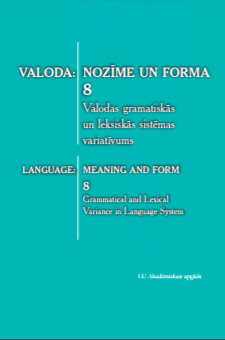Vertikālā virzība ἀνά ‘augšup’ un κατά ‘lejup’– prefiksi salikteņos ar grieķu verbu λαμβάνω ‘ņemt’
The vertical direction ἀνά ‘up’ and κατά ‘down’: the case of the prefixed Greek verb λαμβάνω ‘take’
Author(s): Ieva Fībiga, Ilze RūmnieceSubject(s): Language studies, Morphology, Syntax
Published by: Latvijas Universitātes Akadēmiskais apgāds
Keywords: Greek verb λαμβάνω; prepositions 'up' / 'down'; vertical movement; meaning change;
Summary/Abstract: This article focuses on the analysis of the Greek verb λαμβάνω ‘take, capture, gain’ and its semantics of potential vertical movement through the prepositions ἀνά ‘up’ and κατά ‘down’. The verb λαμβάνω with the two prepositions is widely used in both Ancient and Modern Greek. Its meaning for the vertical movement can be observed both in the direct and modified and figurative sense, therefore observations based on language diachrony may also be possible. The investigated material is considered comparatively, by juxtaposing the meanings and developmental features of the compound verbs with ἀνά and κατά. It is concluded that the dimension of position/direction as represented by the semantics of the prepositions in composite verbs often turn into a time dimension, indicating either an initiated or repetitive (ἀνά), or a finite, completed action (κατά). Both prepositions in combination with different verbs can also express an emphasis or amplification of the action; however, in compounds with λαμβάνω, only the κατά element generally performs such a function.
Journal: Valoda: nozīme un forma
- Issue Year: 2017
- Issue No: 8
- Page Range: 167-172
- Page Count: 6
- Language: Latvian

